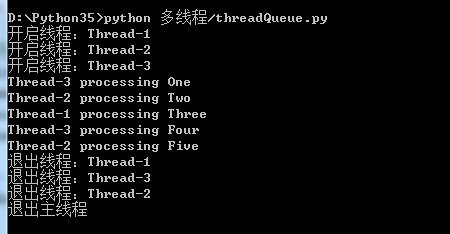多线程同步和优先级队列(Queue)
线程同步
如果多个线程共同对某个数据修改,则可能出现不可预料的结果,为了保证数据的正确性,需要对多个线程进行同步。
使用 Thread 对象的 Lock 和 Rlock 可以实现简单的线程同步,这两个对象都有 acquire 方法和 release 方法,对于那些需要每次只允许一个线程操作的数据,可以将其操作放到 acquire 和 release 方法之间。如下:
多线程的优势在于可以同时运行多个任务(至少感觉起来是这样)。但是当线程需要共享数据时,可能存在数据不同步的问题。
考虑这样一种情况:一个列表里所有元素都是0,线程"set"从后向前把所有元素改成1,而线程"print"负责从前往后读取列表并打印。
那么,可能线程"set"开始改的时候,线程"print"便来打印列表了,输出就成了一半0一半1,这就是数据的不同步。为了避免这种情况,引入了锁的概念。
锁有两种状态——锁定和未锁定。每当一个线程比如"set"要访问共享数据时,必须先获得锁定;如果已经有别的线程比如"print"获得锁定了,那么就让线程"set"暂停,也就是同步阻塞;等到线程"print"访问完毕,释放锁以后,再让线程"set"继续。
经过这样的处理,打印列表时要么全部输出0,要么全部输出1,不会再出现一半0一半1的尴尬场面。
实例:
#!/usr/bin/python3 import time import threading exitFlag = 0 class myThread(threading.Thread): def __init__(self, threadID, name, counter): threading.Thread.__init__(self) self.threadId=threadID self.name=name self.counter=counter def run(self): print("开始线程:" + self.name) # 获取锁,用于线程同步 threadLock.acquire() print_time(self.name, self.counter, 5) print ("退出线程:" + self.name) # 释放锁 threadLock.release() #输出线程 def print_time(threadName, delay, counter): while counter: if exitFlag: threadName.exit() time.sleep(delay) print ("%s: %s" % (threadName, time.ctime(time.time()))) counter -= 1 # 创建新线程 thread1 = myThread(1, "Thread-1", 1) thread2 = myThread(2, "Thread-2", 2) threadLock = threading.Lock() # 添加线程到线程列表 threads=[] threads.append(thread1) threads.append(thread2) # 开启新线程 t0=time.clock() print("开始计算时间",t0) for t in threads: t.start() # 等待所有线程完成 for t in threads: t.join() print ("退出主线程") print(" 结束计算实",time.clock()-t0)
线程优先级队列( Queue)
Python 的 Queue 模块中提供了同步的、线程安全的队列类,包括FIFO(先入先出)队列Queue,LIFO(后入先出)队列LifoQueue,和优先级队列 PriorityQueue。
这些队列都实现了锁原语,能够在多线程中直接使用,可以使用队列来实现线程间的同步。
Queue 模块中的常用方法:
- Queue.qsize() 返回队列的大小
- Queue.empty() 如果队列为空,返回True,反之False
- Queue.full() 如果队列满了,返回True,反之False
- Queue.full 与 maxsize 大小对应
- Queue.get([block[, timeout]])获取队列,timeout等待时间
- Queue.get_nowait() 相当Queue.get(False)
- Queue.put(item) 写入队列,timeout等待时间
- Queue.put_nowait(item) 相当Queue.put(item, False)
- Queue.task_done() 在完成一项工作之后,Queue.task_done()函数向任务已经完成的队列发送一个信号
- Queue.join() 实际上意味着等到队列为空,再执行别的操作
实例:
#!/usr/bin/python3 import queue import threading import time exitFlag = 0 #自定义多线程类 class myThread (threading.Thread): def __init__(self, threadID, name, q): threading.Thread.__init__(self) self.threadID = threadID self.name = name self.q = q def run(self): print ("开启线程:" + self.name) process_data(self.name, self.q) print ("退出线程:" + self.name) #公共方法 def process_data(threadName, q): while not exitFlag: queueLock.acquire() if not workQueue.empty(): data = q.get() queueLock.release() print ("%s processing %s" % (threadName, data)) else: queueLock.release() time.sleep(1) #变量定义区 #线程名列表 threadList = ["Thread-1", "Thread-2", "Thread-3"] #执行优先级标记列表 nameList = ["One", "Two", "Three", "Four", "Five"] #线程同步锁 queueLock = threading.Lock() #队列列表 workQueue = queue.Queue(10) #线程列表 threads = [] threadID = 1 # 创建新线程创建并运行了3个 for tName in threadList: thread = myThread(threadID, tName, workQueue) thread.start() threads.append(thread) threadID += 1 # 填充队列,填充5个 queueLock.acquire() for word in nameList: workQueue.put(word) queueLock.release() # 等待队列清空 while not workQueue.empty(): pass # 通知线程是时候退出 exitFlag = 1 # 等待所有线程完成 for t in threads: t.join() print ("退出主线程")
输出结果:

问题:3个线程没错,但是输出了5次。为什么会输出5次?


 浙公网安备 33010602011771号
浙公网安备 33010602011771号